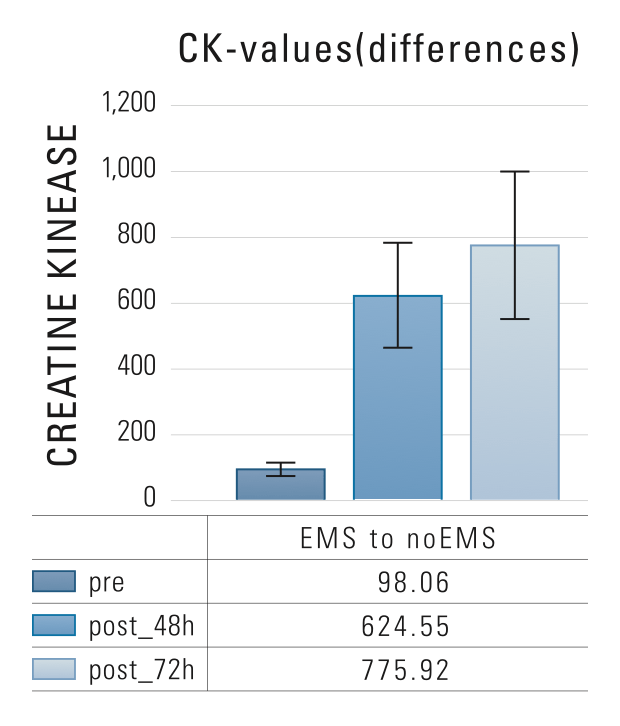Evidence on the effect of training with e-skin EMStyle
- From 2021 Interim Report
EMS-based Running To Enhance Performance Collaboration Xenoma – Its
Prof. Dr. Daniel Memmert
Professor and Executive Head of the Institute of Exercise Training and Sport Informatics at the German Sport University Cologne. He studied physical education for high school teachers and holds a PhD in sports science from the Elite University of Heidelberg. In 2010 he was awarded 3rd place with Germany's most renowned German Olympic Sports Confederation (DOSB) Science Award.

1Muscle demand which lasts up to 72 h after workout
The body's enzyme creatine kinase which represents muscle load rises significantly after doing a workout while wearing the EMStyle suit. Compared to training without the suit, CK values rise to around 6.2 times 48 hours after training and to around 7.8 times 72 hours after training. [see graph 1]
Temporal changes in creatine kinase blood levels with and without the EMStyle suit [graph 1]
CK: creatine kinase
CK-values(differences)=(CK EMS - CK noEMS)÷ CK noEMS

2The efficiency of the fat metabolism per energy expenditure is high
When using the suit while running, the fat metabolism rate per energy expenditure is higher than when running without the suit. [see graph 2]
Energy metabolism [graph 2]
CHO: carbohydrates

3Even during an aerobic workout, adding EMS provides a muscle training effect
When doing aerobics training, there is usually not much of a muscle training effect. However, wearing the EMStyle suit while running means that a muscle training effect can be achieved as shown in graph 1.
Aerobic training (running) measured while wearing the EMStyle suit

Aim of the Study
The aim of this study is to investigate the impact of eight-weeks intervention with Wb-EMS on metabolic and muscular function compared to training intervention without Wb-EMS.
Methods
Twenty Healthy participants (min. 30 years old) were included with no or minor EMS and running experience. The exercise test was conducted twice; one time with and one time without the EMStyle suit. During the exercise, respiratory gas analysis was conducted. Creatine Kinase testing was conducted before and after the exercise test. In accordance with the latest revision of the Declaration of Helsinki, all subjects gave written informed consent to the experimental procedure which was approved by the ethics committee of the German Sports University (001/2021).
Currently (March 2021), a study is being conducted to investigate performance during running with the EMS suits in cooperation with the German Sports University Cologne, Institute of Exercise Training and Sport Informatics, Germany. The pictures show the use of the suit at different running speeds including performance diagnostics (03-12-21)